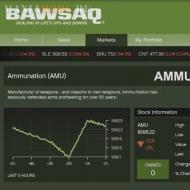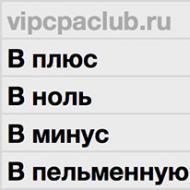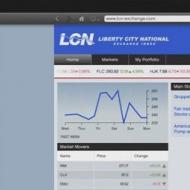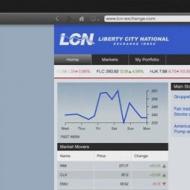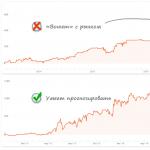
Comparison of models of Markovitsa and Sharpe. Formation of the investment portfolio, their types and classification. Questions for self-test
Modern portfolio theory is based on the use of statistical and mathematical methods. Its distinctive feature is the relationship between market risk and income, namely: the investor must form a relatively risky portfolio to count on a relatively high income. The use of this approach requires a certain computer and mathematical support. In many cases, the combination of the approaches listed above will be strategically correct.
To date, two models for determining the characteristics of the portfolio are the most common: the Markovic model and the Sharpe model. Both models are created and successfully operated in the conditions of the concerned concerns about stable Western stock markets. Unfortunately, the Ukrainian stock market is still stable yet. Therefore, an attempt was made to create a model capable of successfully functioning in conditions of emerging, developing and reorganizing stock marketWhat is today and is the stock market of Ukraine. The proposed model was called "Quasi-Sharpe" (due to the similarity in general features With the Sharpe model) and will be shown below.
Model Markovica
In 1952, Harry Markovitz published a fundamental work that is the basis of an approach to investments from the point of view of the modern theory of portfolio formation. The engineering approach begins with the assumption that the investor at the moment has a specific amount of money for investing. This money will be invested for a certain period of time, which is called Holding Period. At the end of the speaking period, the investor sells securities that were bought at the beginning of the period, after which it uses the received income into consumption, or reinves income into various securities (or also does both at the same time).
The engineering approach to the decision makes it possible to adequately take into account both these goals. The consequence of the presence of two contradictory goals is the need for diversification by purchasing not one, but several valuable papers.
The model is based on the fact that the indicators of the profitability of various securities are interconnected: with increasing yields of some papers, there is simultaneous growth over other papers, the third remains unchanged, and on the fourth on the contrary, the yield is declining. This type of dependence is not deterministic, i.e. Uniquely defined, and stochastic and is called the correlation.
The Markovic model is rational to use with a stable state of the stock market, when it is desirable to form a portfolio of securities of a different nature belonging to various industries. The main disadvantage of the model of the Markovic - the expected profitability of securities is made equal to the average profitability according to previous periods. Therefore, the Markovic model is rational to use with a stable state of the stock market, when it is desirable to form a portfolio from securible papers of various nature, having a more or less long life in the stock market
Sharp Model
Sharpe model considers the relationship of the yield of each security with the market yield as a whole. The main idea of \u200b\u200bthe model is that the investor does not accept risk and is ready to go on it only if it implies additional benefits, i.e. Increased rate of return on invested capital compared with the risk-free investment. As a risk-free rate, the rate of return on long-term government bonds with a maturity is usually 10 to 20 years. The Sharpe model is used mainly when considering a large number of securities describing most of the stock market. The main disadvantage of the model is the need to predict the profitability of the stock market and the risk-free rate of profitability. This model does not take into account the risk of oscillations of risk-free yields. In addition, with a significant change in the relationship between the risk-free profitability and profitability of the stock market, the model gives distortion.
Model "Quasi-Sharpe"
Models of Markovic and Sharpe were created and successfully operated in Western stock markets, which have stability and comparative predictability. In countries with economies in transition, stock markets are at the stage of formation and development. Permanent reorganization occurs. Ukraine's stock market is no exception. In such conditions, the use of models of Markovic and Sharpe leads to distortions associated with the instability of the quotations of securities and the stock market as a whole.
Sharpe model considers the relationship of the yield of each security with the market yield as a whole.
The main assumptions of the Sharpe model:
As profitability Security is accepted mathematical expectation of profitability;
There is some risk-free return rate , i.e., the yield of some security whose risk always minimal compared to other securities;
Interconnection deviations profitability of security from the risk-free rate of profitability(Further: deviation) from deviations profitability of the market as a whole from the risk-free rate of profitability (Further: deviation of market yields) Describes linear regression function ;
Under the risk of the security is understood degree dependency changes in the return of security from changes in the market profitability as a whole;
It is believed to past Periods used in calculating profitability and risk are fully reflected future Values \u200b\u200bof profitability.
According to the Sharpe model, the deviation of the valuable scope is associated with the deviations of the market yield function of the linear regression of the form:
where is the deviation of the profitability of the security of the riskless;
Deviation of the yield of the market from risk-free;
Recession coefficients.
Based on this formula, it is possible by the projected profitability of the securities market as a whole to calculate the yield of any security, its component:
where, the regression coefficients characterizing this valuable paper.
Theoretically, if the securities market is in equilibrium, the coefficient will be zero. But since in practice the market is always unbalanced, it shows excessive yield This securities (positive or negative), i.e. As far as this securities is revalued or underestimated by investors.
The coefficient is called -Risk, since it characterizes the degree of dependence of the deviations of the valuable paper from the deviations of the market yield as a whole. The main advantage of the Sharpe model - mathematically substantiated interdependence of yield and risk: the more risk, the higher the profitability of the security.
In addition, the Sharpe model has a feature: there is a danger that the estimated deviation of the profitability of the security will not belong to the constructed regression line. This risk is called residual risk. The residual risk is characterized by the degree of scattering of values \u200b\u200bof deviations of the profitability of the security relative to the regression line. Residual risk is defined as an average quadratic deviation of empirical points of the profitability of the valuable paper from the regression line. The residual risk of I - oh the securities is denoted.
In other words, the risk indicator of investment in this valuable paper is determined by risk and residual risk.
In accordance with the Sharpe model, the yield of securities portfolio is a secondary weighted value of the indicators of the profitability of securities, its components, including risk. The yield of the portfolio is determined by the formula:
where - risk-free yield;
The expected yield of the market as a whole;
The risk of securities portfolio can be found by estimating the average quadratic deviation of the function and is determined by the formula:
 ,
,
where is the average quadratic deviation of the yield of the market as a whole, i.e. the market risk indicator as a whole;
Risk and residual risk of I - essential paper;
Using the Sharpe model to calculate the portfolio characteristics, the direct task acquires the view:

The inverse task looks likewise:

With the practical application of the Sharpe model, the following assumptions and formulas are used to optimize the stock portfolio.
one). Usually, the yield of state securities, such as the bonds of the domestic state loan, is taken as a risk-free return rate.
2). As the profitability of the securities market as a whole, the period t uses expert assessments of market profitability from analytical companies, from the media, etc. In the conditions of the developed stock market for these purposes, it is customary to use any stock indices. For not very large in the number of securities of the stock market, the average value of the profitability of the securities constituting the market for the same period T:
where - the profitability of the securities market in the period T;
The initial data for the calculation (profitability of securities) remain unchanged (see Table. 4.9.1). In addition, the Sharpe model provides for the use of the yield of the market as a whole and risk-free yield. The yield of the market as a whole was made on the basis of expert assessments, due to the lack of data from external sources. As a risk-free profitability, the yield of three-month state short-term bonds given for a weekly term. Data on the yield of the market as a whole and on risk-free returns are presented in Table. 4.9.5.
The rules for constructing the border of effective portfolios allowed by the Markovian make it possible to find the optimal (from the point of view of the investor) a portfolio for any number of securities in the portfolio. The main complexity of the application of the Mankovic method is a large amount of calculations required to determine the Wi-based scales of each securious. Indeed, if the portfolio unites p securities, then to build the boundaries of effective portfolios, it is necessary to pre-calculate p values \u200b\u200bof expected (medium-sized arithmetic) profitability E.(r.i) each securities, p variables of dispersions of all returns and p(p - 1) / 2 covariance expressions Σ i, J shares in the briefcase. With an increase in the number of securities in the portfolio, the number of required covariance values \u200b\u200bbecomes exorbitantly large. For example, if an investor wants to form a portfolio of 30 shares, it needs to be calculated 435 covariances, 30 expected returns and 30 dispersions, i.e. Total about 500 quantities! If the number of securities to double (up to 60), then the investor will already need 1770 covariance values \u200b\u200bplus 120 values E.(r.i) and Σ j. And with 100 securities in the portfolio, the required amount of source data exceeds 5000.
In 1963, American economist W. Sharp ( William. Sharpe) proposed a new method for building the boundary of effective portfolios, which makes it possible to significantly reduce the volume of necessary computing. In the future, this method was modified, currently known as the Sharpe One-Indidex Model. The following are the main stages of building this model.
General description of the model
At the heart of the Sharpe model lies linear Regression Analysis Method allowing you to connect two random dependent variables X. and Y. Linear expression type
In the Sharpe model as a dependent variable Y. Return is taken r.i, T some i-J. Portfolio shares measured for selected calculation steps. Independent variable X. The value of some market indicatoraffecting the return stock of the portfolio. Such an indicator may be, for example, the growth rate of gross domestic product, the level of inflation, the price index of consumer goods, etc. Sharpe himself as an independent variable considered the yield of the market portfolio r.t, T calculated for the same calculation steps based on the index Standard and poor "S. (S & P500.). Expression (3.12) is called linear regression equation, and constant coefficients but and β are considered linear regression parameters.
In Russian conditions yield r.t, T market portfolio can be assessed using domestic RCB indices (for example, MICEX index or the RTS index). If the duration of the holding period is specified and the index values \u200b\u200bare known. I. at the beginning I.and at the end I.confining period, the yield of the market portfolio for this period is by the formula
Construction of the regression model
For visual presentation of the content of the Sharpe model, suppose that the portfolio is formed from the stakes previously discussed A, B. and FROM. Let the duration of the future holding period (for the subsequent comparison of the Sharpe model with the Markovian model, we assume that this duration coincides with the chosen duration in the Markovian model). Let us ask also N. \u003d 10 steps of calculation in the past (which coincides with the initial conditions entered in the last chapter for example in Markovitsa). Based on data on changes in the market index (obtained from open sources), calculate profitability r.t, T market portfolio for selected N. Calculation steps. The resulting data will be brought in Table. 3.5, where profitability also r.c, T shares FROM, Calculated earlier.
Table 3.5
Conditional yield of the market portfolio and stock FROM
In this case, for the promotion FROM Linear regression equation (3.14) should take
![]()
Strictly speaking, you can choose any values \u200b\u200bof parameters αc and βc, realizing that theoretical values \u200b\u200bobtained from this expression r.C, T will differ from the actually observed values \u200b\u200b(see Table 3.5).
For example, if you select αc \u003d 0.1, and βc \u003d 0.5, then theoretical value r.C, 1Tore will be
what differs from the observed value r.C, 1Nab \u003d 0.110. To level theoretical and observed values, it is necessary to correct theoretical magnitude r.C, 1TER. This is achieved by adding to the value r.C, 1 error center εС, 1, which is εs, 1 \u003d -0,0505, since (0.1605 - 0.0505 \u003d 0.110).
You can make sure that for the second step of the calculation
also does not coincide with the observed value εС, 2 \u003d 0.320, so it is required to adjust r.C, 2Tore error εС, 2 \u003d + 0.074.
Since quantities r.m, T and r.C, T random, then most likely, the rest of theoretical values r.C, T obtained using the linear regression equation will differ from actually observed values r.C, T shown in Table. 3.5. In connection with this value r.C, T Theore needs to adjust the error ε C, T at every step of the calculation. Since values r.m, T, and r.C, t random, then the values \u200b\u200bof the error ε C, T should also be random variables. As a result, the equation of linear regression for the action FROM Must have the following form:
where ε C, T - random error.
In general, if the portfolio is included p stocks for any Mr. Portfolio shares The linear regression equation is as follows:
where r.i, T - profitability i.Stake in the portfolio t; αi - parameter of linear regression, called the coefficient of "alpha", showing which part of yield i.Shares of the portfolio are not related to changes in the yield of the market portfolio r.m, t; βi - parameter of linear regression, called coefficient "beta", Sensitivity characterizing yield Mr. Portfolio shares to market yield changes r.m, T. ; R.m, T - the yield of the market portfolio at the time t; εm, t - random error, testifying that real observed values r.i, T deviate from theoretical values r.i, TAOR, obtained using linear dependency (3.13).
Equation (3.13) is the main in linear regression analysis and is taken as a basis in the Sharpe model. In linear regression analysis, it is assumed that the average arithmetic (expected) observation errors Ε (ε i, T) = 0, i.e. Actual values r.i, t on average evenly distributed above and below the values \u200b\u200bobtained by linear regression.
Sharpe model considers the relationship of the yield of each security with the market yield as a whole.
The main assumptions of the Sharpe model:
As profitability Security is accepted mathematical expectation of profitability;
There is some risk-free return rate , i.e., the yield of some security whose risk always minimal compared to other securities;
Interconnection deviations profitability of security from the risk-free rate of profitability(Further: deviation) from deviations profitability of the market as a whole from the risk-free rate of profitability (Further: deviation of market yields) Describes linear regression function ;
Under the risk of the security is understood degree dependency changes in the return of security from changes in the market profitability as a whole;
It is believed to past Periods used in calculating profitability and risk are fully reflected future Values \u200b\u200bof profitability.
According to the Sharpe model, the deviation of the valuable scope is associated with the deviations of the market yield function of the linear regression of the form:
where is the deviation of the profitability of the security of the riskless;
Deviation of the yield of the market from risk-free;
Recession coefficients.
The main disadvantage of the model is the need to predict the profitability of the stock market and the risk-free rate of profitability. The model does not take into account the oscillations of risk-free yield. In addition, with a significant change in the relationship between the risk-free profitability and profitability of the stock market, the model gives distortion. Thus, the Sharp model is applicable when considering a large number of securities describing b aboutwe have a more relative to the stable stock market.
41. Jumping premium for risk and beta coefficient.
Risk Market Prize - The difference between the expected yield of the market portfolio and the risk-free bid.
Beta coefficient (beta factor) - indicator calculated for security or securities portfolio. Is a measure market riskReflecting variability profitability Security (portfolio) in relation to portfolio profitability ( market) On average (middling portfolio). In the case of companies that do not have traded in stock market, it is possible to calculate a beta coefficient based on comparison with the indicators of analog companies. Analogs take from the same industry whose business is as much as possible to the business of a non-public company. When calculating, it is necessary to make a number of amendments, in particular, to the difference in the capital structure of compared companies (debt ratios and share capital).
Beta coefficient for an asset in the portfolio of securities, or asset (portfolio) relative to the market is a relationship covaria The magnitude of K. dispersion reference portfolio or market, respectively :
![]()
where - the estimated value for which the beta coefficient is calculated: the yield of the estimated asset or portfolio is the reference value with which there is a comparison: the profitability of the securities or market portfolio - covariator estimated and reference value - dispersion reference value.
Beta coefficient - This is a unit of measure, which gives the quantitative relationship between the movement of the course of this action and the movement of the stock market as a whole. Cannot be confused with variability.
Beta coefficient (Beta Coefficient) is an indicator of the degree of risk in relation to the investment portfolio or to specific securities; reflects the degree of sustainability of the course of the shares compared to the remaining stock market; Sets the quantitative relationship between vibrations of the price of this action and the price dynamics of the market as a whole. If this coefficient is greater than 1, it means that the action is unstable; with beta coefficient less than 1 - more stable; That is why conservative investors are primarily interested in this coefficient and prefer shares with low levels.
The rules for constructing the border of effective portfolios allowed by the Markovic allows you to find the optimal (from the point of view of the investor) a portfolio for any number of securities in the portfolio. The main complexity of the application of the Mankovic method is the large amount of calculations required to determine the scales Wieach valuable. Indeed, if the portfolio combines N valuable bucket, then to build the boundary of effective portfolios, it is necessary to pre-calculate n.values \u200b\u200bof expected (medium-sized arithmetic) profitability E (RI)each security n.values from 2 I.dispersion of all the standards of return and n (N1) / 2pairing covariance expressions a i J.securities in the portfolio.
In 1963, American economist William Sharpe proposed a new method of building the boundary of effective portfolios, which makes it possible to significantly reduce the volume of necessary computing. In the future, this method was modified and currently known as single model Sharpe ( Sharpe SingleIndex Model).
General description of the model.The Sharpe model is based on the linear regression analysis method, which allows you to associate two random variables of an independent x and dependent Y linear expression Y \u003d a + (sxh. In the Sharpe model, the magnitude of some market index is considered to be independent. Such may be Growth of gross domestic product, inflation rate, consumer goods index, etc. Sharpe itself as an independent variable considered the yield rMComputant based on the Standart and Poor S index (S & P 500). The yield is taken as a dependent variable rI.some I am a secular. Since often the S & P 500 index is considered as an index characterizing the securities market as a whole, then usually the Sharpe model is called market Model,and profitability rM yield market Briefcase.
Let yield rMtakes random meanings and for N. Calculation steps were observed rM 1, RM 2, ..., RMN. At the same time return rI.some i oh the security was valid rI 1, RI 2, ..., Rin. In this case, the linear regression model allows you to provide the relationship between RM and RI values \u200b\u200bin any observed point in the form of:
a.i parameter, a constant component of a linear regression, showing which part of the yield of I essentially is not related to changes in the yield of the RM securities market;
P.i parameter of linear regression, called beta,showing the sensitivity of the profitability of I essentially to changes in market profitability;
rm t yield of the market portfolio at time t;
sIT A random error indicating that the real values \u200b\u200bof Ri t and Rm t pore deviate from linear dependence.
Of particular importance should be given to the parameter P I, since it determines the sensitivity of the yield of I essentially to changes in market profitability.
In general, if th\u003e 1, then the yield of this security is more sensitive, is subject to large fluctuations than the RM market yield. Accordingly, for P.j.< 1 ценная бумага имеет меньший размах отклонений доходности rj от средней арифметической (ожидаемой) величины E (r) j , чем рыночная доходность. В этой связи ценные бумаги с коэффициентом r\u003e 1 are classified as more risky than the market as a whole, and with r< 1 менее рискованными.
As studies show, for most securities r\u003e 0, although securities can meet with a negative value

Assessment of regression results.The parameters α i and β I regression model give an idea of \u200b\u200bgeneral trends in relationships between
Definition of parameters AI and regression model No..To walk the parameters a.i I. P.i according to the results of observations is used method of least squares (MNC).By this method as parameters a.i I. P.i take such values \u200b\u200bthat minimize the sum of the squares of errors in. If you need the necessary calculations, it turns out that the parameters a.i I. P.i take the following values:
changes in the RM market indicator and the rate of return Ri. However, values a.i I. j.do not allow to give a definite answer about degreesimilar interconnection. The accuracy of the regression model has a significant effect of E I error. It means that the accuracy of the regression model, the degree of relationship of RM and RI, is determined by the scattering of random errors, which can be estimated using a dispersion of a random error.
In addition, the accuracy of regression can be determined by estimating how precisely the regression model determines the dispersion but] securities for
which make up the regression model.
Dispersion of securities but] can be represented in the form of two terms:

In this case, the first term will show what sharein the overall risk of securities can be described using a regression model (Ri T \u003d a.i + P IRM T), and the second term degree of inaccuracy of the regression model. So, the closer the value ^ A. 2 /but] closer to one, the more accurate regression model.
It should be borne in mind that the correlation coefficient square is a generally accepted measure of estimating linear regression, that is, the measure of how precisely the regression equation is suitable for describing the ratios of real data Ri T and Rm t.
Since to determine the optimal portfolio using the Sharpe model, you will need dispersions ^ random
errors, MO calculate them. The general formula for calculating the dispersion of a random error has the form:
IN this case The average arithmetic value is calculated by the division by (n 2), since two degrees of freedom were lost when calculating a.i and P i.
The use of the Sharpe market model to build the boundaries of effective portfolios.One of the main advantages of the Sharpe model is that it can significantly reduce the volume of calculations when determining the optimal portfolio, while giving results closely coinciding with the Markovic model obtained. Since the Sharpe model is based on linear regression, it is necessary to introduce a number of prerequisites for its application. If we assume that the investor forms a portfolio from securities, then we will assume that:
1) The average arithmetic (expected) value of random errors E (ε i) \u003d 0 for all securities of the portfolio, that is, for i \u003d 1, 2, ..., n.
2) dispersion of random errors σ ε 2 , I.for each secular paper is constant.
3) For each specific security, there is no correlation between the random errors observed during N years.
4) There is no correlation between random errors of any two securities in the portfolio.
5) There is no correlation between random errors ε i and a market profitability.
Using these simplifications, it is possible to obtain expressions E (RI), Σ I. 2 I.

Σ i, j for any securities in the portfolio:
Let's summarize: if the investor forms a portfolio from n securities, then the use of linear regression parameters a.i I. P.i allows you to express with their help all the initial elements the expected return E (RI) of each securious in the portfolio, dispersion but 2 and covaria
b i j The rate of these securities required to build the boundaries of effective portfolios. In this case, the investor is required to pre-calculate n.values \u200b\u200bI, n.values \u200b\u200bp i, n values < , as well as e (rm) and a 2 m. Therefore, it will be necessary to find: (n + n + n +2) \u003d 3 n +2 initial data, which is significantly less than the volume of calculations for the model of the Markovic.
Determination of the expected profitability and dispersion of the portfolio.
The expected yield of a portfolio consisting of n securities is calculated by the formula

To give this compactness formula, Sharpe proposed to consider the market index as a conditional characteristic (n +1) secular paper in the portfolio. In this case, the second term equation can be represented as:


So, we note the main stages that need to be performed to build the boundaries of effective portfolios in Sharpe Models:
1) Select N securities from which the portfolio is formed, and to determine the historical gap into N of the calculation steps, for which the values \u200b\u200bof the yield Ri, T each securities will be observed.
2) at a market index (for example, AK & M), calculate the market yield RM, T for the same period of time.
3) Determine the values \u200b\u200bof β i:

5) Calculate dispersions σ ε 2 I.errors regression model
6) Substitute these values \u200b\u200bin equation (7.15 - 7.18)
After such a substitution, it turns out that unknown values \u200b\u200bare the weights of Wi securities. By choosing a certain amount of expected yield of the E * portfolio, you can find weight securities in the portfolio, build the boundary of effective portfolios and determine the optimal portfolio.

